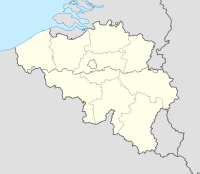Battle of Haelen
| Battle of Haelen | |||||||
|---|---|---|---|---|---|---|---|
| Part of the Battle of the Frontiers in World War I | |||||||
 Contemporary postcard depicting the "failure of the German cavalry" at Halen. |
|||||||
|
|||||||
| Belligerents | |||||||
|
|
|
||||||
| Commanders and leaders | |||||||
|
|
|
||||||
| Strength | |||||||
| 5 regiments 2,400 cavalry 450 infantry cyclists |
6 regiments 4,000 cavalry 2,000 infantry |
||||||
| Casualties and losses | |||||||
| 160 killed 320 wounded |
150 killed 600 wounded 300 captured |
||||||
|
|
|||||||
The Battle of Halen (also Haelen or the Battle of the Silver Helmets, Dutch: Slag der Zilveren Helmen French: Bataille des casques d'argent, because of the many cavalry helmets left behind on the battlefield by the German Cuirassiers.) took place on 12 August 1914 at the beginning of the First World War and was a cavalry encounter between German forces led by Georg von der Marwitz and Belgian troops led by Léon de Witte. In 1914, Halen was a small market town and a convenient river crossing of the Gete River; the town was also on the principal axis of advance of the Imperial German army. The battle was a tactical victory for the Belgians but did little to delay the German invasion of Belgium.
On 3 August the Belgian government refused a German ultimatum and the British government guaranteed military support to Belgium should Germany invade. Germany declared war on France, the British government ordered general mobilisation and Italy declared neutrality. On 4 August, the British government sent an ultimatum to Germany and declared war on Germany at midnight on 4/5 August, Central European time. Belgium severed diplomatic relations with Germany and Germany declared war on Belgium. German troops crossed the Belgian frontier and attacked Liège. A week after the German invasion, German cavalry had been operating towards Hasselt and Diest, which threatened the left flank of the army on the Gete. Belgian General Headquarters chose Halen as a place to delay the advance and make time to complete an orderly retreat to the west. The Belgian Cavalry Division was sent from Sint-Truiden to Budingen and Halen, to extend the Belgian left flank.
...
Wikipedia

